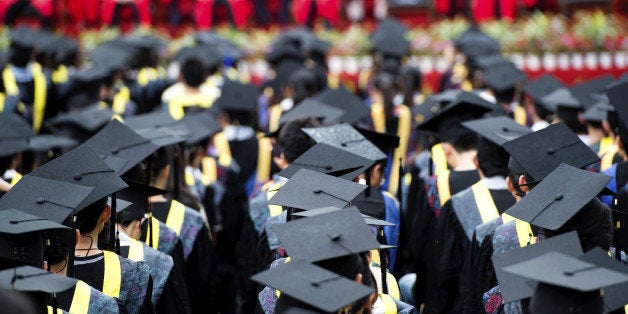
Co-Written with Mark Huelsman
There is a tendency among elite opinion makers to believe that debt accrued while gaining a college degree is "good debt" that isn't problematic because, as the thought goes, those with college degrees tend to make enough money to recoup their debt over a lifetime. Student debt is supposedly an equalizer -- a way for students to gain access to credit in order to get a degree that will give them an equal chance to enter the middle class and achieve the American Dream. Sadly, like many pundit platitudes, this assertion is grounded in fantasy, not fact.
In fact, this is only true for some students -- those who were fairly wealthy in the first place. College is certainly worth the cost, but that at present it is saddling poor and middle-class students with student debt is actually preventing them from participating in the wealth-building processes that previous generations have enjoyed.
The debate over student debt usually focuses on those right out of school, but that masks that a substantial portion of those with student debt struggle mightily to pay off their loans in a timely manner, delaying (sometimes in perpetuity) their entry into the middle class. Research by the US Federal Reserve Bank of New York finds that many borrowers still haven't paid off their student loans by their 40s and 50s.
For students just out of school, upward of 15 percent of their federal student loans are in default within three years of students leaving school, and delinquency rates for student loans have continued to rise during and after the recession, even as delinquencies in every other form of loan -- including mortgages, home equity loans, credit cards, and auto loans -- have declined.
The inability to pay off debt is a really big deal, because these students are more likely to take any job that comes their way to pay off their loans than invest in themselves. Research from Demos finds that if "current borrowing patterns continue, student debt levels will reach $2 trillion sometime around 2022. Another report concludes that, "an average student debt burden for a dual-headed household with bachelors leads to a lifetime wealth loss of nearly $208,000." Given that wealth inequality has returned to Gilded Era heights, this finding should be disturbing.
The problem is that, rather than being seen as a social investment, college education is increasingly seen as a commodity -- something that is accessible for the wealthy, but out of reach for the poor, and increasingly, the middle class. Sure enough, student debt is highly correlated to income level with the wealthiest having the lowest amount of debt as a portion of their income (see table).
Poor and middle class students are much more likely to take on student loans -- in fact, nearly 9 in 10 graduates who receive Pell Grants also needed to borrow to finance their degree, compared to 53 percent of graduates who did not receive Pell Grants. These students will spend more time paying off their debt and less time saving for retirement or other needs, creating a vicious cycle of deepening wealth inequality.
There is a more tenuous, but equally important way in which rising inequality has increased student debt among the poor and middle class -- through the political system. Recently, Martin Gilens and Benjamin Page sent the internet alight with their assertion that "economic elites and organized groups representing business interests have substantial independent impacts on U.S. government policy, while average citizens and mass-based interest groups have little or no independent influence." This finding is corroborated by Larry Bartels, Dorian Warren, Jacob Hacker, Paul Pierson and Kay Lehman Schlozman who have all recorded similar findings.
Although this elite and corporate control of the political system is bad a priori, it has particular importance in the case of education. In their study of the political attitudes of the wealthiest 1 percent, Larry Bartels, Benjamin Page and Jason Seawright find that the wealthiest 1 percent have different policy priorities than average voters. For instance, while 78 percent of the general public agree with the statement, "The federal government should make sure that everyone who wants to go to college can do so," only 28 percent of the wealthy agree. Elites are also far less likely to agree that, "The federal government should spend whatever is necessary to ensure that all children have really good public schools they can go to," by a margin of 35 percent to 87 percent. They also believe that cutting deficits is a more important priority than funding education, and believe that education is a lower spending priority than the middle class.
This helps explain why states have slashed spending for education while also cutting taxes -- those with the most influence over policy have little to gain from public education, but much to gain from cutting taxes. It also explains why there is very little national attention paid to community colleges, which educate 4 in 10 college students, and who are disproportionately impacted by state budget cuts. Research by Greg Duncan and Richard Murnane shows that wealthy spend far more supplementing their children's incomes than the poor, which means that state level cuts have a devastating impact on the poor (see chart).
Robert Hiltonsmith and Tamara Draut find that in the aftermath of the Great Recession, 49 states (all but North Dakota) cut spending on higher education and that state spending on higher education hit an all-time low in the wake of the recession (see chart). This, essentially, results in higher tuition. Draut and Hiltonsmith find that, "Nationally, average tuition at four-year public universities increased by 20 percent in the four years since 2008 after rising 14 percent in the four years prior." Tuition continues to grow as a share of the median income, which means all families but the very rich have to take out large debts to pay for their education. This, in turn, means that recent graduates are paying off loans, rather than building wealth.
College is an important pathway to the middle class and one of the most effective ways to fight inequality. As it becomes increasingly difficult for students to gain an education, it closes gateways to upward mobility. The effect is particularly potent for blacks. A recent study by Bhashkar Mazumder finds that, "blacks have experienced substantially less upward intergenerational mobility and substantially more downward intergenerational mobility than whites." He finds that this gap shrinks among those with 16 years of schooling.
One simple way to move away from the debt-for-diploma system is for the government to shift from a policy of loans to a policy of grants. There is no reason why college education should primarily be funded by expensive, high interest loans. In the past, Pell Grants helped the poor and middle class attend college, but Pell Grants make up an increasingly low percentage of the cost for college (see chart).
At a bare minimum the government could allow students to refinance their debts at a lower level; most other countries have policies that allow students to pay off debts as a portion of their income and eventually allow the debts to be forgiven. In Britain, students don't begin paying off their loans until they find stable employment, and then they pay in proportion to their earnings. Australia similarly ties the cost of paying off the loan to the income of the graduate, and loans themselves come with no interest attached. In Denmark, education is considered a right by the people and an investment by the government, and is therefore free. Some students are even offered a stipend by the government to defray costs. Norway and Sweden have similar systems of higher education. The US has attempted to implement loan repayment schemes that allow students to pay in accordance with their income, but the default repayment plan on federal student loans is still an arbitrary 10-year time period -- a time when borrowers tend to make less, and when saving for retirement could benefit them the most. But enrollment in these plans have been slow, likely due to the fact that our system is needlessly complex and opaque (to wit, there are upwards of 9 different repayment plans one can choose on student loans).
Education, and especially college education is a pathway to the middle class, and most Americans think it is more important than ever. But as society becomes more unequal, access to debt-free education becomes harder and harder.
